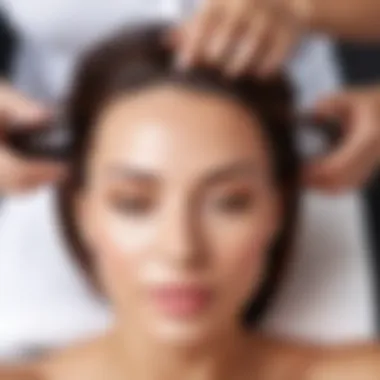Effective Strategies for Promoting Healthy Hair Growth


Intro
The pursuit of thick, vibrant hair is a universal desire that transcends age and gender. People are often on the lookout for effective strategies that can promote hair growth. Understanding how to support this quest is essential not just for aesthetic appeal, but also for overall hair health. Many individuals find themselves lost in the sea of products and recommendations, often adopting a trial-and-error approach.
This article aims to cut through the noise, presenting a rich tapestry of information rooted in science and practical application. Strategies will span nutritional enhancements, natural remedies, and topical treatments, with a focus on creating a personalized care regimen that addresses unique hair needs.
Ürün İncelemesi
Hair growth products can often look similar at first glance; however, digging into their ingredients and benefits reveals much. Consumers need to be discerning when choosing resources to foster hair growth.
Ürün Tanıtımı
Several products are particularly noted for their contributions to enhancing hair growth. Look for those fortified with vitamins such as biotin or blends containing minoxidil which are often touted for their effectiveness. For example, the Rogaine Foam is widely recognized for its role in stimulating hair follicles. Natural approaches also have their place; products featuring castor oil or peppermint oil are often praised for their nourishing properties.
Ürün Özellikleri
Different products have distinct features. Here are some key attributes to look for:
- Natural Ingredients: Products with minimal synthetic chemicals tend to be more effective and safer for prolonged use.
- User Testimonials: Look for feedback from users who have experienced real growth.
- Clinical Backing: Many promising products utilize clinically proven ingredients. For instance, castor oil contains ricinoleic acid which is believed to enhance blood circulation to the scalp.
Güzellik İpuçları
Moving onto beauty tips, it's essential to remember that hair health often mirrors our overall wellness. Making simple adjustments in lifestyle can yield significant changes.
Doğal Güzellik Yöntemleri
- Essential Oils such as lavender and rosemary have been credited with promoting hair growth when diluted properly and massaged into the scalp.
- Scalp Massages: Regularly massaging the scalp can stimulate blood flow. Consider setting aside 5 to 10 minutes daily to enhance your routine.
Sağlıklı Beslenme ve Güzellik
Diet plays a pivotal role in hair growth. Nutritional choices enrich not only the body but also the hair:
- Proteins are the building blocks of hair. Incorporating sources like eggs, poultry, and legumes can significantly impact growth.
- Iron: This mineral is crucial for hair strength. Red meat, spinach, and lentils can help fill this need.
"A well-balanced diet not only nourishes the body but also serves as the foundation for radiant hair."
Understanding Hair Growth
Understanding hair growth is critical for anyone aiming to improve their hair health. This knowledge provides the groundwork for effective strategies needed to encourage growth and maintain the quality of one’s hair. Being aware of how hair grows helps in recognizing what influences this process and how external factors can be managed or addressed. Additionally, an informed perspective aids in setting realistic expectations and personal goals when it comes to hair care.
The Hair Growth Cycle
Hair growth follows a complex cycle that has three key phases, each with its specific characteristics and duration. Recognizing these stages helps individuals understand the natural rhythm of their hair and informs their approach to promoting growth.
Anagen Phase
The Anagen phase is the most crucial stage of the hair growth cycle. It is the active growth phase, where hair strands emerge from the scalp and extend, often lasting several years. This phase is essential for lengthening hair as it can last anywhere from two to seven years, depending on individual genetics.
During this time, hair receives vital nutrients and energy from the scalp’s environment. A key characteristic of the Anagen phase is its capacity for regeneration. By focusing on promoting the health of the hair follicles during this period, one can maximize hair length and strength, making this phase particularly significant for anyone looking to enhance their hair growth.
One unique feature of the Anagen phase is that it allows for hair exposure to regrowth treatments. Practices that stimulate blood flow to the scalp, such as scalp massages or topical applications that nourish hair follicles, can be especially advantageous during this period. However, if hair care practices are not properly aligned with this phase, it could result in stunted growth or damage.
Catagen Phase
In the Catagen phase, which lasts about two to three weeks, hair growth slows significantly, and hair follicles begin to shrink. This phase represents the transitional stage where hair detaches from the blood supply, marking the end of the active growth period.
This process is important as it allows for the shedding of older hair to make way for new growth. Its key characteristic is the termination of the growth cycle for the hair strands that have reached their full potential, paving the way for fresh hair development during the next Anagen phase. It might seem disadvantageous at first as hair thickness may fluctuate, but it’s a natural progression that enables the renewal of hair.
Keeping in mind that not all strands will enter this phase simultaneously, this stage’s unique aspect may not lead to noticeable changes at once, making understanding this cycle beneficial for managing expectations.
Telogen Phase
The Telogen phase marks the period of rest and shedding. This stage usually spans around three months, during which hair is at rest and can fall out easily. While this may seem like a drawback, it is a vital part of the recurring hair growth cycle, allowing new hair to take its place.
The primary characteristic of the Telogen phase is that it provides the hair time to rejuvenate, enabling follicles to prepare for a new cycle of growth. Importantly, this phase includes both healthy and old hair, which is why individuals often notice shedding during this time.
What sets the Telogen stage apart is its focus on homeostasis for hair follicles. They can replenish their resources, setting the stage for a robust Anagen phase. Overall, while it can initially appear disadvantageous due to hair loss, awareness of this pause in growth highlights the cycle’s importance in achieving strong, healthy hair.
Factors Affecting Hair Growth
Hair growth does not happen in isolation. Various external and internal factors influence the rate and health of hair growth. Understanding these elements can illuminate the path to healthier hair.
Genetics
Genetics play an undeniable role in determining hair characteristics and growth potential. Each individual inherits unique traits that largely dictate the thickness, texture, and even the speed of their hair growth.
A significant aspect of genetics is its contribution to the hair growth cycle itself, including the duration of each phase. This can be a double-edged sword; while some may benefit from rapid growth and high-density hair, others may face challenges like thinning or slower growth due to hereditary factors. Recognizing genetic influences encourages people to focus on what can be changed through personal care practices rather than fighting against nature.
Age
Age can have a profound impact on hair growth. As people age, their hair tends to become thinner and grows at a slower rate. The hormonal changes that accompany aging can lead to changes in the hair growth cycle, particularly diminishing the Anagen phase's duration and effectiveness.
Emphasizing age means acknowledging that maintaining healthy hair may require more targeted efforts as one progresses through life. Special care in nutrition and topical treatments becomes essential to counterbalance age-related hair challenges. Understanding these shifts can lead to proactive measures that adapt hair care regimens over time, rather than waiting to address issues as they arise.
Health Conditions
Underlying health conditions can significantly impede hair growth. A various array of factors, from hormonal imbalances like thyroid disorders to deficiencies in essential nutrients, can halt the hair growth process.
The key characteristic here is that health directly correlates with one's overall physical state, making it crucial to prioritize wellness. Managing existing health conditions and ensuring that the body receives necessary vitamins and minerals can foster an environment conducive to hair growth. Conversely, neglecting health may further exacerbate hair difficulties, illustrating the importance of holistic care that includes both external treatments and internal health management.
Understanding these factors establishes a framework for a personalized approach to hair care. By recognizing the interplay of the hair growth cycle, genetics, age, and health conditions, individuals can devise methods to create a nurturing and productive hair care routine.
Nutritional Practices
When it comes to promoting hair growth, the role of nutrition cannot be overlooked. Good nutrition provides the body with the necessary building blocks to strengthen hair and stimulate its growth. An appropriate dietary intake not only fuels your hair's growth cycles but also amplifies overall well-being. This section delves into the specific nutrients essential for hair growth and how to create a balanced diet that supports this endeavor.


Essential Nutrients for Hair
Vitamins
Vitamins play a crucial role in maintaining healthy hair. Vitamin A is one of the key players here. It helps in the production of sebum, which keeps the scalp moisturized, thus promoting healthy hair growth. Additionally, the B-vitamins, particularly Biotin, have gained popularity as they encourage keratin production. This is essential because keratin is one of the primary proteins that make up hair strands.
The interesting thing about these vitamins is their accessibility; they can be found in a plethora of foods. Leafy greens, nuts, and dairy products tend to be rich in these nutrients. However, it's important to note that excessive vitamin intake isn't beneficial; moderation is the name of the game.
Minerals
Moving on to minerals, Iron and Zinc are touted as indispensable for hair health. Iron helps in oxygen transportation in the blood, which directly affects hair growth. A deficiency can lead to hair loss, making this mineral particularly vital for maintaining vibrant hair. On the other hand, Zinc supports the structure of hair follicles. It's like a glue that holds everything together, if you will.
Both of these minerals are abundantly found in foods like spinach, legumes, and meat. However, the catch is that mineral absorption can be tricky; sometimes the presence of other factors in a meal can inhibit their uptake, so it's wise to pay attention to meal combinations.
Proteins
At the heart of hair integrity is protein. Hair is primarily made up of a protein called keratin. Without adequate protein intake, hair may become weak and brittle, leading to breakage. Including enough proteins in your diet can bolster hair strength and minimize loss.
Great sources of protein encompass eggs, fish, and legumes. However, like with other nutrients, quality matters. Having a variety of protein sources can ensure your body gets the complete amino acids needed for optimal growth. Neglecting this aspect can manifest in thinning hair, so it’s crucial to incorporate protein-rich foods into daily meals.
Dietary Recommendations
Balanced Diet
A balanced diet is fundamental for anyone wanting to encourage hair growth. It acts as the cornerstone, providing a spectrum of essential nutrients. This means not just focusing on one food group but rather ensuring that all necessary macronutrients and micronutrients are well-represented in meals.
The uniqueness of a balanced diet lies in its adaptability; you can tweak it based on dietary preferences or restrictions. This adaptability makes it particularly beneficial as it can cater to different backgrounds and lifestyles.
Hydration
Hydration also plays a vital role in overall hair health. The primary function of water is to facilitate cell function, and hair follicles are no exceptions. Staying hydrated lends support to the moisture levels of your hair, preventing it from becoming dry and brittle.
While people often underestimate hydration, it’s crucial to note that even mild dehydration can affect the look and feel of your hair. Aiming for a consistent water intake throughout the day will go a long way in maintaining that coveted shine.
Foods to Favor
It's also important to be mindful of the specific foods you include in your diet. Certain foods, such as salmon, avocados, nuts, and spinach, are not only packed with the essential vitamins and minerals but also contribute healthy fats that are vital for hair health.
The distinctive feature of these foods is their synergistic effects; they don’t just benefit hair growth; they also promote skin health and boost overall energy levels. Thus, steering clear of heavily processed foods and instead focusing on whole, nutrient-dense options can lead to a more gratifying result.
"Nutrition is a critical pillar when it comes to nurturing hair growth; it doesn't just boost strands but also your overall health."
In summary, nutritional practices serve as the backbone of any effective hair growth strategy. By understanding the individual contributions of vitamins, minerals, and proteins, as well as the significance of a balanced diet and hydration, individuals can take significant steps towards achieving their hair growth goals.
Topical Treatments
When it comes to hair growth, topical treatments can play a pivotal role in providing essential nutrients directly to the scalp and hair. While nutrition and overall health form the cornerstone of any growth strategy, applying specific oils, shampoos, and conditioners can significantly enhance the results. The right topical products are not just about aesthetics; they can help rejuvenate hair, strengthen strands, and create an environment conducive to growth. Moreover, with so many options out there, understanding what works best for individual needs is crucial. It’s like finding the right key for a lock—once you have it, everything can fall into place.
Effective Hair Oils
Coconut Oil
Coconut oil is highly regarded in the realm of hair care. Its unique composition allows it to penetrate the hair shaft, providing deep hydration and reducing protein loss. Because of its rich fatty acid content, coconut oil forms a protective barrier around the hair, guarding against damage. Using coconut oil can improve the overall health of hair while leaving it shiny and soft. Many swear by it for its ability to minimize breakage—vital for longer hair growth.
However, individual results may vary. For some, coconut oil can be too heavy, leading to greasy strands if used excessively. Finding the right quantity and application method—perhaps as an overnight treatment or pre-wash—involves some trial and error.
Castor Oil
Castor oil holds a special place in hair growth discussions. This oil is loaded with ricinoleic acid, which is known to improve blood circulation to the scalp. Improved circulation means better nourishment for hair follicles, encouraging growth. Many people appreciate its thick consistency, which often translates to a thorough application and robust support.
Though it is praised for its potential, castor oil does have its quirks. Its heavy texture can be a disadvantage; it isn’t for everyone. Some might find it too sticky or challenging to wash out, which might deter regular usage. So, a balance is key when incorporating it into a hair care routine.
Jojoba Oil
Jojoba oil is often hailed as one of the best oils for hair due to its similarity to the natural oils produced by the scalp. This similarity means it can effectively moisturize without clogging pores. It's particularly beneficial for those struggling with a dry scalp or dandruff, which can impede healthy hair growth.
What separates jojoba oil from many others is its light texture. This makes it suitable for all hair types, from fine strands to thick coils. It doesn’t weigh hair down, which can be a concern with heavier oils. However, its availability can sometimes be limited based on location, which might pose accessibility issues for some.
Shampoos and Conditioners
Ingredients to Seek
When choosing shampoos and conditioners, it's critical to look for ingredients that promote healthy hair growth. Ingredients such as biotin, keratin, and niacin are known for their contributions to hair strength and health. Biotin aids in keratin production, while niacin helps improve blood circulation in the scalp, all of which supports hair follicles.
Select products that feature natural extracts like rosemary oil and tea tree oil. These have been noted for their properties in scalp health and enhancing growth by reducing dandruff and flaking.
On a more thoughtful note, avoid products with sulfates. These can strip hair of its natural oils, leading to dryness and breakage—a counterproductive approach when trying to optimize hair health.
Products to Avoid
Equally important is being aware of what to avoid when shopping for hair products. Many consumers find themselves at the mercy of marketing, but caution is wise here. Products containing parabens, phthalates, and excessive fragrances can disrupt the scalp’s natural balance.
Additionally, stay wary of anything overly harsh or abrasive. These can cause irritation and can lead to accelerated hair loss. Learning to read labels can go a long way in ensuring the safety and efficacy of the products used.
"To achieve great lengths of hair, one must incorporate both nourishment and protection in their regimen."
By understanding and implementing effective topical treatments, individuals can unlock the full potential of their hair growth efforts. Whether it’s through the application of nourishing oils or choosing the right shampoos, each element plays an integral role in maintaining and enhancing the health of hair.
Mechanics of Hair Care
When it comes to promoting hair growth, the mechanics of hair care play a crucial role. Understanding how to effectively manage and care for your hair can significantly impact its health and appearance. This section dives into how proper hair care practices can enhance growth and prevent damage. By focusing on scalp maintenance and suitable styling methods, you not only nurture your strands but also create a healthy environment for new hair to flourish.
Scalp Health
Maintaining a healthy scalp is fundamental in any hair growth regime. A clean and well-nourished scalp encourages hair follicles to operate at their best. Neglecting scalp health can lead to issues such as dandruff or irritation, which may impede hair growth.


Exfoliation Techniques
Exfoliation techniques are a fantastic way to ensure the scalp remains free of dead skin and excess oil. Regular exfoliation promotes blood circulation, allowing nutrients to reach hair follicles more efficiently. One popular method involves using a gentle scrub specifically designed for the scalp.
The key characteristic of these exfoliation techniques is their ability to shed the old and pave the way for the new. They help clear away any build-up that might suffocate hair follicle function. A distinctive feature of these methods is the use of natural ingredients, like sugar or salt, often combined with oils for added nourishment.
While this technique presents various advantages, such as enhanced scalp health and potential stimulation of hair growth, one must be cautious not to over-exfoliate. Excessive scrubbing can result in irritation, leading to the very issues we're trying to avoid in the first place.
Massage Benefits
Combining scalp exfoliation with massage can amplify its benefits. Massage benefits extend beyond mere relaxation; they actively stimulate blood flow to the hair follicles, which can encourage growth. Employing circular motions with your fingertips for a few minutes daily can significantly improve scalp circulation.
A notable characteristic of this technique is its simplicity and accessibility. No special tools or products are necessary; just your fingers and a bit of time can make a difference. However, it’s essential to apply gentle pressure, as using too much force might lead to discomfort or even hair loss.
Styling Practices
In addition to managing scalp health, attention to styling practices is necessary for promoting hair growth. How you treat your hair during styling plays a key role in its overall health.
Heat Protection
Heat protection is vital for maintaining hair integrity. Using hot styling tools like straighteners or curling irons can cause significant damage to hair strands. A good heat protectant creates a barrier between the hair and the heat, allowing for styling without compromising hair health.
The core advantage of employing a heat protection product is the preservation of moisture and elasticity. This barrier prevents the cuticles from cracking and splitting. What’s unique about heat protectants is their formulation, often rich in silicones and oils, which help smooth the hair and reduce frizz.
However, there are some downsides to be aware of; not all heat protectants are equal, with some leaving residues or greasiness that can weigh hair down. Hence, experimenting to find the right one for your hair type is beneficial.
Protective Styling
Protective styling is another essential strategy that can help protect your strands. Styles such as braids, buns, or twists shield the ends of your hair from damage caused by environmental factors and friction. They can be a refuge for your hair, reducing everyday wear and tear.
A key characteristic of protective styles is that they allow for longer durations without needing to manipulate your hair frequently. This means less potential breakage and damage. Sometimes, these styles can be quite low-maintenance while looking chic. However, caution should be taken, as overly tight styles can lead to traction alopecia, a condition caused by excessive pulling on the hair.
Lifestyle Factors
Lifestyle factors play a significant role in supporting hair growth. While many people focus on topical treatments or dietary supplements, lifestyle habits can often be the unsung heroes in achieving luscious locks. Both stress and sleep quality are critical elements that impact hair health, and improving these areas can lead to noticeable benefits. Here, we break down how managing stress and ensuring quality sleep can positively influence hair growth.
Stress Management
Meditation Techniques
Meditation has become quite a buzzword in today’s fast-paced world, and for good reason. This practice involves focusing the mind and eliminating distractions, which can significantly lower stress levels. Stress is known to contribute to hair loss, so integrating meditation into your routine can be a game changer.
One key characteristic of meditation is its simplicity. You don’t need any fancy equipment or special skills—just a quiet space and a few minutes each day. The advantageous aspect of meditation is that it fosters a sense of calm and helps to balance emotions, making it a popular choice for those seeking to improve not just mental clarity but also physical aspects of health, including hair growth.
However, it’s worth considering the unique feature of meditation: the requirement for consistency. It might take some time for individuals to notice the benefits in terms of hair health. For some, the quiet moments can feel awkward at first, but persistence can yield significant results over time.
Yoga Practices
Practicing yoga is another effective way to manage stress. This ancient practice combines physical postures, breathing techniques, and meditation, all of which contribute to reducing tension in the body and mind. The movements can stimulate circulation, including to the scalp, making it a beneficial choice for supporting hair growth.
A distinctive feature of yoga is its accessibility; no matter your fitness level, you'll find poses to fit your needs. The dual advantage lies in not just physical exercise but also mental well-being, reinforcing its reputation as a holistic remedy. However, it may require some time to become familiar with the different poses and to experience the full breadth of its benefits.
Sleep Quality
Importance of Sleep
Quality sleep cannot be overstated when it comes to hair growth. When the body is at rest, it engages in important repair and regeneration activities, including those related to hair follicles. Poor sleep can lead to hormonal imbalances which can hinder the growth process.
A significant characteristic of essential sleep is its role in not only hair but also general health. During deep sleep phases, the body releases growth hormones—critical elements for healthy hair growth. The majestic cycle of sleep underscores why ensuring enough shut-eye is often touted as a key factor in natural beauty routines. However, many struggle with sleep issues, and addressing these concerns can often be an uphill battle.
Creating a Sleep Routine
Establishing a sleep routine is crucial for harnessing the benefits of restful sleep. This might include setting a specific bedtime, creating a relaxing environment, and limiting screen time before bed. One primary characteristic of a regular sleep schedule is that it can cue your body to wind down, making it easier to drift off.
The unique feature of a sleep routine is that it not only boosts hair health but also improves overall well-being. Inconsistent sleep patterns can lead to erratic mood swings and decreased productivity, so developing a regular routine can have far-reaching advantages. As with any habit, initial changes to your routine may feel challenging, but the payoff can certainly be worth the effort.
Avoiding Damage
In the journey toward promoting healthy hair growth, avoiding damage is as crucial as implementing growth strategies. Damage to hair can stifle its growth potential and lead to further complications. By understanding the common pitfalls in hair care and recognizing damaging behaviors, individuals can foster an environment that supports hair resilience and vitality.
Common Mistakes in Hair Care
Over-Washing
Over-washing hair is a widespread mistake that many make, believing that frequent washing leads to cleaner, healthier tresses. In reality, overwashing can strip natural oils, leaving hair dry and brittle. The key characteristic of this mistake lies in the misconception that hair needs to be washed every day. In fact, depending on hair type, washing hair two to three times a week might be sufficient.
The unique feature of over-washing is how it disrupts the scalp's natural balance. By eliminating oils too often, dryness turns into itchiness, often prompting individuals to resort to heavy conditioners that weight down the hair instead of nourishing it.
- Advantages of avoiding over-washing:
- Disadvantages of over-washing:
- Preserving natural oils helps maintain moisture.
- Reduces the frequency of heat exposure from styling.
- Increases chances of damage and breakage.
- Can lead to an unhealthy scalp, affecting growth.
Use of Harsh Chemicals
The use of harsh chemicals in hair care is another common trap. Many commercial shampoos and treatments contain sulfates and parabens, which can lead to dryness and irritation. The key characteristic of these chemicals is their effectiveness in cleaning but at a cost. They remove dirt but also strip away essential oils.
By incorporating gentler alternatives such as sulfate-free options, individuals can avoid the damage that harsh chemicals inflict. The unique feature of shifting to milder formulations is that they cleanse without eradicating essential moisture.
- Advantages of using gentle products:
- Disadvantages of harsh chemicals:
- Maintains natural moisture balance.
- Reduces irritation and sensitivity on the scalp.
- Can lead to excessive dryness and static.
- Long-term use may contribute to thinning of the hair.


Heat and Chemical Treatments
Safe Practices
When it comes to styling, safe practices can make all the difference. Though many people utilize heat for styling, setting boundaries is essential to minimize damage. The key characteristic of safe heat use is to always apply a heat protectant before using tools like curling irons or flatirons. This simple addition can act as a barrier between heat and hair, reducing potential damage.
Additionally, limiting the use of high temperatures—sticking to a medium setting instead—can yield better long-term results. The unique feature of such practices lies in their ability to allow creative expression while protecting hair integrity.
- Advantages of safe heat styling:
- Disadvantages of ignoring safe practices:
- Allows for versatile hairstyles without sacrificing health.
- Protects overall hair quality, promoting strength.
- Increases the risk of split ends and breakage.
- Can lead to long-term texture changes or damage.
Alternative Solutions
For those looking to avoid damaging hair with heat and chemicals altogether, alternative solutions offer a viable path. Techniques such as braiding damp hair for waves or using foam rollers can style without heat impact. The key characteristic of these alternatives is their ability to support both aesthetics and hair health. Techniques that rely on setting hair through tension rather than heat often yield impressive results without compromising the strand’s quality.
An additional focus on natural methods, including air drying, proves beneficial for maintaining moisture levels. The unique feature here is that they cater to creativity and health simultaneously.
- Advantages of alternative methods:
- Disadvantages of conventional styling:
- Reduced risk of heat-related damage.
- Often free from harsh chemicals, fostering true hair health.
- Might require more time to achieve looks compared to immediate heat applications.
By consciously avoiding damage, individuals empower themselves to create optimal conditions for hair growth, leading to vibrant, healthy locks.
Monitoring Progress
Monitoring progress is a critical aspect when it comes to promoting hair growth. It helps individuals assess the effectiveness of their strategies over time and adjust them as needed. Just like a gardener tending to their plants, observing changes and making adjustments can dictate the success of one's hair growth journey.
Setting Realistic Goals
Understanding Growth Rates
Understanding growth rates is pivotal in managing expectations. Hair typically grows about half an inch per month on average, but this can vary based on numerous factors including genetics and overall health. Recognizing this rate is a key characteristic as it will help individuals set achievable goals. Knowing that a normal growth rate might not yield the long, flowing hair desired in the short span of time can save one from the discouragement of unrealistic expectations. Additionally, it allows for a more patient approach. A unique aspect of understanding growth rates is the realization that some phases of life—such as during stress or certain seasons—can temporarily halt growth, showcasing the need for adaptable strategies.
Timeframe Expectations
Timeframe expectations play an equally important role in the hair growth journey. Often, people might think that a major transformation can happen overnight; however, true change takes time. Setting a realistic timeframe enables individuals to acknowledge that significant results may not appear until several months of consistent effort. A notable feature of timeframe expectations is its ability to foster patience, encouraging individuals to remain committed to their hair care routine. Nevertheless, a downside might be the potential for sheer frustration, especially if one is eagerly awaiting visible signs of progress. A proper expectation management not only aligns with actual hair growth but also nurtures a more positive mindset during the entire process.
Tracking Improvements
Tracking improvements is a useful method to gauge effectiveness and stay motivated. By documenting changes over time, individuals can notice patterns, which may encourage the continuation of positive practices and adjustment of ineffective ones.
Journaling Techniques
Using journaling techniques can be profound in one’s hair growth journey. This method allows individuals to record daily observations, product usage, and even emotional states connected with their hair care. A key aspect of journaling is its reflective quality, enabling individuals to see what strategies yield the best results. It functions as a living document to track changes and insights. The unique feature of journaling lies in its personal touch; it captures not just numerical data but feelings and experiences too, offering a deeper understanding of one's journey. However, maintaining a consistent journal can be daunting, especially in the hustle of daily routines.
Visual Documentation
Visual documentation stands out as another engaging way to track hair growth progress. Taking regular photos provides a clear visual representation of changes that might be missed on a day-to-day basis. This method can offer immense motivation since tangible evidence of growth is often far more compelling than mere words or feelings. A significant benefit of visual documentation is the immediate feedback it provides, allowing for quicker adjustment of strategies if results are not as expected. However, a potential pitfall could be over-reliance on visual evidence, which might lead to discouragement if one doesn't see the desired changes immediately.
"Patience is the companion of wisdom." – St. Augustine. Keeping this in mind while monitoring progress can really make a difference in the journey toward achieving beautiful hair.
Professional Treatments
When it comes to achieving effective hair growth, professional treatments often stand out as a valuable option. These methods are not just about instant fixes; they dive deeper into root causes and provide tailored solutions. Working with experts in dermatology offers insights into underlying issues many might not consider.
Dermatologist Recommendations
Consultations
A consultation with a dermatologist can be a game-changer for individuals seeking answers about their hair. These consultations provide an opportunity to discuss personal hair concerns in a focused setting with an expert. Dermatologists assess your hair type, scalp condition, and possible health issues that could affect growth. This personalized approach is often viewed as a beneficial step to pinpoint specific problems that could hinder progress.
The beauty of these consultations lies in their detailed analysis. Dermatologists utilize tools like scalp evaluations or hair pull tests, allowing for a comprehensive understanding of your situation. Following this assessment, they can suggest a more effective and tailored treatment plan.
The unique feature of these consultations is the personal touch. Instead of guessing, your concerns are met with expertise to devise a roadmap for healthy hair growth. Though costs can be higher than over-the-counter solutions, the targeted nature of these assessments can yield more significant results, often justifying the expense.
"Consulting with an expert allows for a tailored approach that addresses specific hair issues."
Possible Treatments
Once consultations are completed, dermatologists often recommend treatments that align with your diagnosis. Options can range from minoxidil to finasteride, among others, tailored to the individual’s needs. These treatments often have documented success rates, making them a popular choice for many.
The key advantage of possible treatments is their scientific backing. Many of these options have undergone rigorous testing, allowing individuals to feel confident in their effectiveness. Moreover, dermatologists remain on the cutting edge of advancements in hair restoration, ensuring patients receive the latest options available.
However, it’s important to note that not all treatments suit everyone. Individual responses vary, and there's often a need for trial and error to find the best fit. This uniqueness means that while you might find a solution that works wonders for one person, it might not have the same effect on you.
Alternative Therapies
When seeking ways to promote hair growth, don't underestimate the power of alternative therapies. These routes may serve as supplementary options alongside conventional treatments.
Acupuncture
Acupuncture has gained traction as a potential ally in boosting hair health. This traditional Chinese therapy aims to enhance blood circulation in the scalp and promote relaxation, which can indirectly support hair growth. It’s popular because many find it appealing as a natural method without the side effects associated with some medications.
The key characteristic of acupuncture is its focus on restoring balance. Placing needles in specific points may help alleviate stress, often cited as a significant factor in hair loss. People who have participated in these sessions frequently report feeling a sense of calm, which can be beneficial for overall hair health.
Nevertheless, the unique nature of acupuncture means that individuals need to approach it with an open mind. Results can be gradual, and not everyone might experience noticeable benefits. Yet, it remains a viable option for those searching for complementary solutions to hair growth.
Herbal Remedies
Herbal remedies present another layer of possibilities for those on the path to healthier hair. From rosemary oil to ginseng, various herbs are known for their positive effects on scalp health and promoting growth.
These remedies are often viewed as accessible and easy to incorporate into daily routines. The natural components appeal to a wide audience interested in avoiding synthesized products. Still, it’s essential to approach them with careful consideration.
While many find herbal options appealing, the efficacy can vary significantly among individuals. Some might notice significant improvements, while others see little to no change, making it crucial to research and possibly consult with a professional before diving in.
In summation, professional treatments provide a structured pathway to address hair growth concerns. By considering insightful consultations and exploring a range of possible treatments, alongside alternative therapies, individuals can build a comprehensive approach they trust and can personalize based on their needs.







